Welcome to an exploration of the remarkable Humboldt Penguin. These adorable penguins call the rugged coast of South America home, specifically Peru and Chile.
In this article, we’ll uncover 14 fascinating facts about Humboldt penguins from their physical characteristics, behaviors, and even how they built nests out of poop.
1. They live in South America
Humboldt Penguins are found along the pacific west coast of South America, from Isla Foca in Peru down to Isla Guafo in southern Chile.
Although they spend most of their lives at sea, they breed on land where their habitat is diverse and includes rainforest, coastal caves, and rocky shorelines1 (source: IUCN).
The map below gives a rough indication of where each penguin species lives.
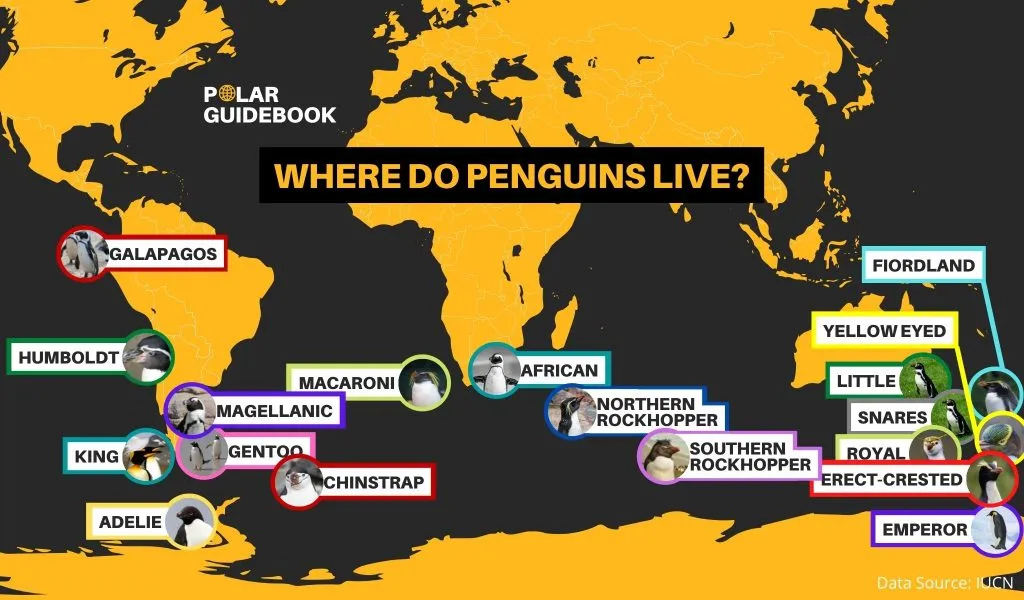
2. The lifespan of a Humboldt penguin is 15-20 years in the wild
The lifespan of a Humboldt penguin in the wild is estimated to be between 15-20 years old. This is about average for a penguin with most species living to around 20.
In captivity, penguins live a little longer, typically around 30 years although there have been documented cases of penguins living to the ripe old age of 40 in captivity.
3. They are black and white to blend in with the ocean
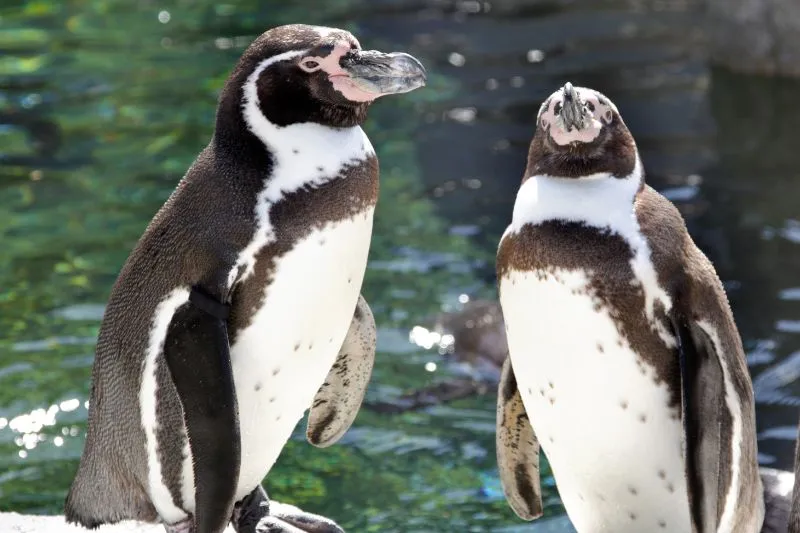
Penguins have evolved a unique way of blending into their surroundings. Their black and white plumage, known as countershading, serves as a powerful camouflage in the water, where they spend the majority of their lives.
The white belly blends seamlessly with the lighter surface waters when viewed from below, while the black back provides an excellent disguise against the darkness of the deeper waters when viewed from above2 (source: H.M. Rowland, The Royal Society B Biological Sciences, Issue 364, 2008).
4. They are closely related to Magellanic and African Penguins
Humboldt penguins are part of a family known as banded penguins. They are very closely related to other banded penguins including Magellanic and African penguins as well as Galapagos penguins to a lesser extent.
They are so similar that some people question whether Magellanic, African, and Humbodlt penguins are different species or not. Especially given that they interbreed together in captivity and when their range overlaps in the wild (such as in Chile where you can find both Magellanic and Humbodlt colonies).
5. They are medium-sized penguins standing at around 68cm tall
Humboldt penguins are average-sized at 68cm (27″) tall. Depending upon the season and gender of the penguin, they can weigh anywhere between 4.5-5kg (10-11 lbs)3 (source: Animal: The Definitive Visual Guide).
Here is a graphic showing how big penguins are by species.
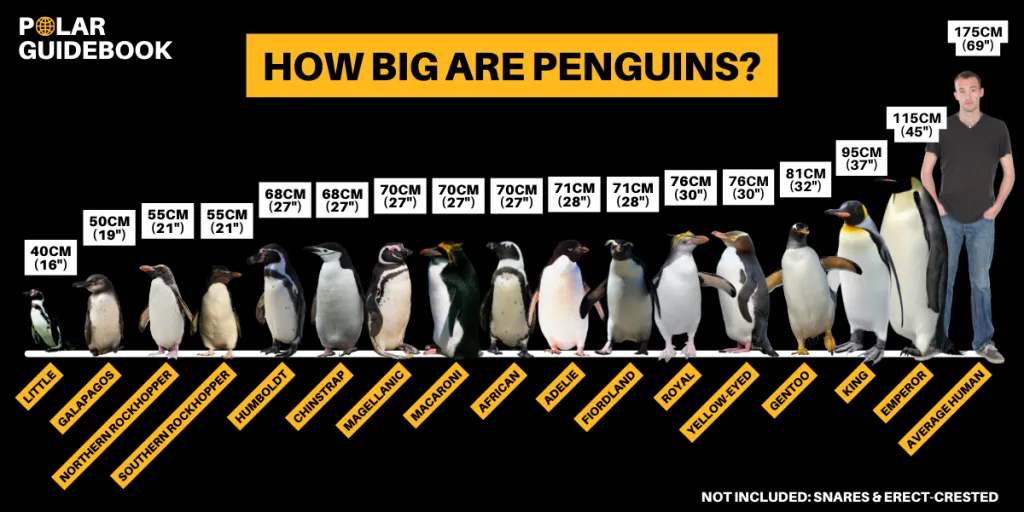
6. Humboldt penguins mostly eat fish
As carnivores, the vast majority of a Humboldt penguin’s diet is fish such as anchovy, silverside, and marcel. However, they also eat squid and crustaceans4 (source: P.D. Boersma and P.G. Borboroglu, Penguins: Natural History and Conservation, 2013).
Penguins catch and eat their food at sea. They will catch prey as they swim upwards and swallow it whole without chewing.
Find out more about the diet of different penguins in our guide to what do penguins eat.
7. They are shallow divers compared to other species
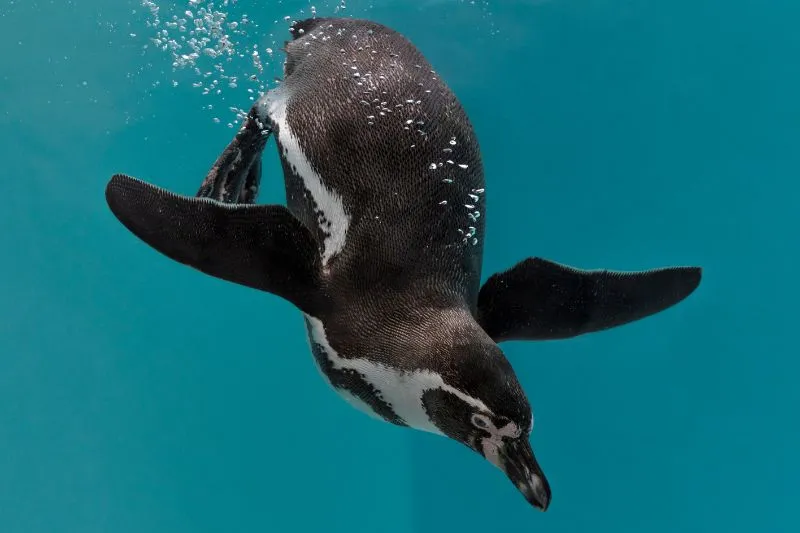
Penguins may spend around 75% of their day-to-day life in the ocean and use it as a hunting ground for catching prey5 (source: S. Moss, Do Birds Have Knees, 2016) so they are good swimmers and divers.
Some species, such as emperor penguins, can dive to depths as deep as 500m. However, this is not the case with Humboldt Penguins. They will rarely dive deeper than 30m6 (sources: Journal of Experimental Biology and Penguins: Natural History and Conservation).
8. They are hunted by whales, sharks, seals, and foxes
Orcas (also known as killer whales), great white sharks, and south American fur seals are the main predators of Humboldt penguins at sea. On land, their main predators are desert foxes7 (source: Penguins: Natural History and Conservation).
Predators introduced by humans, such as dogs and rats, can also prey on Humboldt penguins, although to a lesser extent. Their eggs are also at risk of being hunted by gulls and vultures8 (source: IUCN).
9. They build their nests out of poop
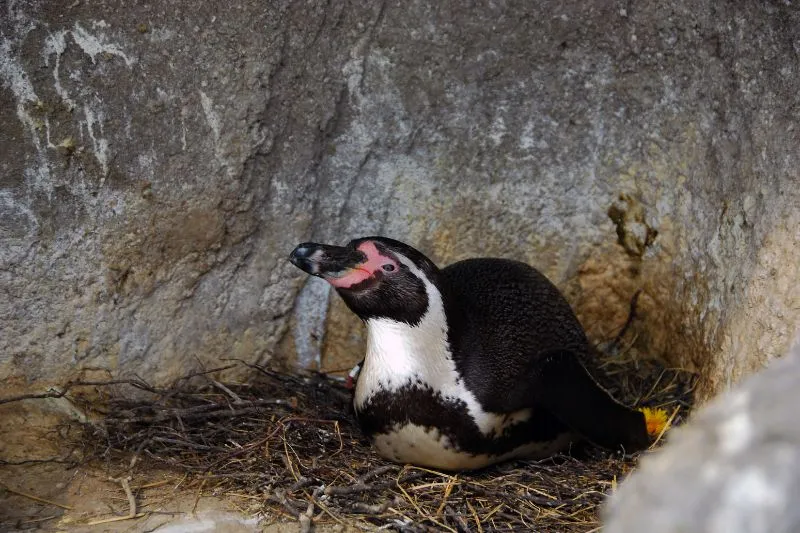
Humboldt penguins build their nests in layers of guano which is the poop of seabirds.
When males first arrive at the breeding ground, they use their feet and flippers to shape the guano and complete their nests using soil and stones. This is where the female will lay her eggs9 (source: Saint Louis Zoo).
Guano is a sought-after product by humans since it is a highly effective fertilizer and is also used in the production of gunpowder and explosives10 (source: Wikipedia).
Unfortunately, over-exploitation of guano has had an impact on Humboldt penguin numbers as it reduces the availability of good nesting areas and guano miners trample and destroy burrows while collecting it11 (source: IUCN).
10. They can be in same-sex partnerships
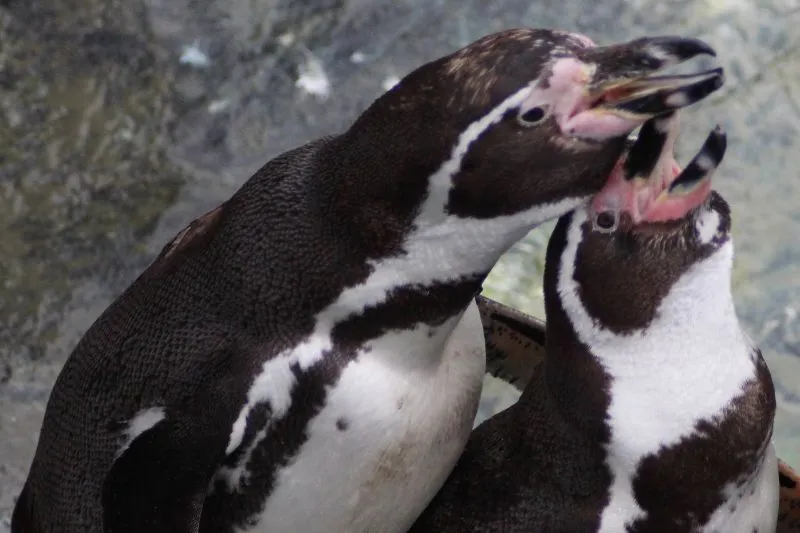
Like many other penguins, Humboldt penguins have been known to engage in same-sex relationships. This happens in the wild and captivity.
Examples of same-sex Humboldt penguins include Vielpunkt and Z at Bremerhaven Zoo, Germany as well as Ronnie and Reggie, Nadja and Zimmer, and Dev and Martin at London Zoo.
Same-sex couples are known to try and steal eggs from straight couples or sometimes they try to hatch rocks. Read our full article on can penguins be gay to find out how zoo keepers are responding.
11. They expel heat through the pink skin around their eyes

Humboldt penguins have adapted to the warmer climate they live in. They have patches of bare skin around their eyes which expel body heat when they get too warm.
You know when they are too hot as they blush pink which also helps them release excess heat12 (source: Great Plains Zoo).
Another way that penguins can expel excess heat is by holding their flippers out. This increases the surface area that is exposed to the air and thus releases heat.
12. They can drink salt water as well as freshwater
Our final Humboldt penguin fact is that they have a special salt gland (known as a super orbital gland) at the top of their skull, near their eye, which removes salt from their blood.
They need this because Humboldt penguins spend most of their lives at sea or around coastal areas of South America where the only water available for consumption is saltwater but their kidney is not very efficient at processing salt.
The salt collected via the gland is excreted in water droplets through their nostrils by sneezing or shaking their head13 (source: Britannica). This means that penguins don’t need to worry about ingesting salt water as they catch and eat their prey out at sea.
13. There are just 23,800 Humboldt penguins left
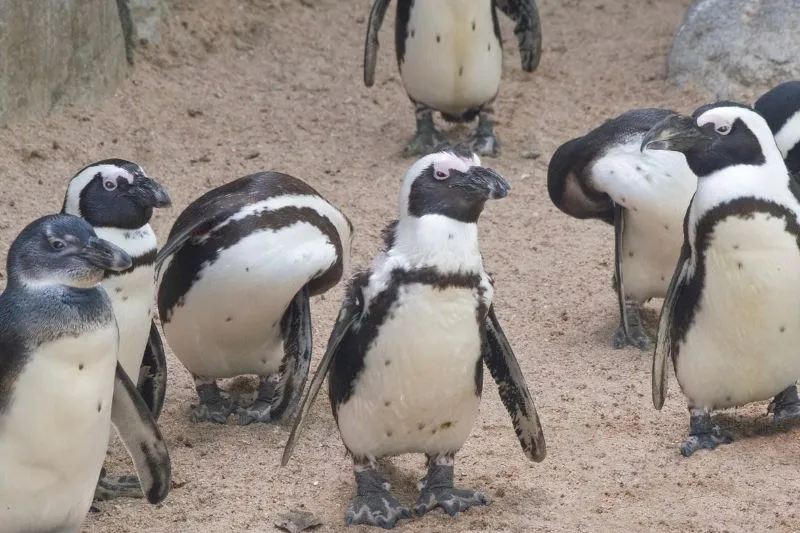
Estimates of the number of Humboldt penguins in the wild suggest there are just 23,800 birds left, making them the third smallest penguin by population, with only yellow-eyed penguins and Galapagos penguins having fewer birds.
For comparison, there are thought to be between 30-31 million penguins left in the wild worldwide.
14. Humboldt penguins are vulnerable to climate change
They have been rated as vulnerable by the IUCN because of the large fluctuations in the sizes of colonies in chile which are where the vast majority of Humboldt penguins can be found. Vulnerable is one level above endangered on their scale.
Humboldt penguin populations have always fluctuated in size due to the ENSO (El-Nino Southern Oscillation) climate pattern, a natural event that causes changes in wind, temperature, and rainfall, subsequently impacting sea conditions and food availability for penguins.
As these cycles become more frequent (due to climate change), Humboldt penguin populations won’t be able to recover from the bad times and may decline rapidly over time14 (source: IUCN).
BONUS: They can sleep with one eye open
Penguins are cathemeral which means they can be irregularly active at day or night (as opposed to nocturnal or diurnal). They are also polyphasic sleepers which means that they take lots of shorter naps rather than one long sleep like humans. These adaptations allow them to be more aware of predators.
The Humboldt Penguin can sleep with one eye open in order to keep an eye out for predators15 (source: N. Rattenborg, Neuroscience & Biobehavioral Reviews, Vol 24, Issue 8, 2000). This is known as unilateral eye closure and involves resting only half of their brain at one time.


![You are currently viewing 14 Humble Facts About Humboldt Penguins [#6 Will Change How You See Them]](https://polarguidebook.com/wp-content/uploads/2023/01/Humboldt-Penguin-2.jpg)
![Read more about the article 12 Ice-Cool Facts About Adélie Penguins [#9 Will Surprise You]](https://polarguidebook.com/wp-content/uploads/2023/01/Adelie-Penguins-Jumping-Over-Ice-300x200.jpg)
![Read more about the article 14 Magnificant Facts About Magellanic Penguins [#9 Will Surprise You!]](https://polarguidebook.com/wp-content/uploads/2023/01/Magellanic-penguins-group-300x200.jpg)
![Read more about the article How Big Are Penguins? [Height & Weight of Every Species]](https://polarguidebook.com/wp-content/uploads/2022/02/how-big-are-penguins-300x176.jpg)